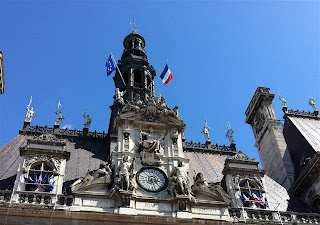
So it was that on Monday May 7th (the day before la Fête de l'Armistice), these three charming school children were not at their École Maternelle in Paris, but were instead with us at the small town of Villedieu-les-Poêles in Normandy, where brass and copper foundries/ateliers and lace making workshops continue the medieval traditions of the region.
Today, the local Chamber of Commerce has devised an amusing and informative game for children. Clad in green medieval capes, and armed with compasses and binoculars, they are sent out around the town in pursuit of a copper thief.

Looking like three little hobbits, they scoured every little nook and cobbled walkway in search of clues to unmask the dastardly thief. So, even though they were missing a school day, they learned how to use a compass, follow directions and have a whole lot of fun, all the while absorbing the history of the area.

The adults followed along happily and we were particularly pleased when the hunt led us to the Atelier du Cuivre, a vast, skylit copper workshop, where artisans have been manufacturing copper pots, pans and other essentials for a few hundred years. We were offered a fascinating tour of the process that transforms the raw material into the most beautiful of items.

These copper wash basins caught my eye, gleaming softly in a corner.
As did this impressive row of hammers, used in the final shaping and stippling process.

In its sprawling size and the dedication of the workers, we were reminded of Idem, the lithograph studio in Paris, both places struggling to hold on to an art form that is in danger of disappearing.

I tried to offer my support by buying this adorable little "saucier" for my next Sauce Béarnaise . (It was the only size I could comfortably handle!)
Last Thursday, May 17, was Ascension Day, and we went to Carentan, Normandy to visit friends for a couple of days. The train was packed, including many families with school age children going for a 4-day weekend, ie taking "le pont" and getting an extra day off!


Along the lanes, the hedgerows are full of the usual buttercups, forget-me-nots and other familiar country flowers, but every now and then something more exotic crops up, like this beautiful wild orchid.
Cotentin itself is a peninsula in the Département de Manche, Basse-Normandie, with the big bustling seaport of Cherbourg at its tip. Tourists pour off the cross-channel ferries. Some take the road to Utah Beach on the south-eastern coast of the peninsula, site of the American Normandy landings in D-Day, but most tend to head inland or south, missing a chance to experience another interesting part of France.

Luckily for us, staying right in the heart of the area, and with our friends as guides, we got to explore both sides of the peninsula, starting at Barnville-Cataret, a seaside town on the western side, with an imposing stone lighthouse, complete with Fresnel lenses.

Looking out to sea, I was astonished to see the island of Jersey (one of the Channel Islands), right there, maybe 5 miles offshore, with Guernsey, Sark and the others just beyond!
 A map mounted on the cliff laid them out for us. It's a real mystery to me how these islands ended up being under English jurisdiction, instead of French, but that's the way it is!!
A map mounted on the cliff laid them out for us. It's a real mystery to me how these islands ended up being under English jurisdiction, instead of French, but that's the way it is!!
Meanwhile, to our right, below the lighthouse, this beautiful, empty beach stretches for miles, bordered with sand dunes. It reminded us of Kehoe Beach in our very own Pt Reyes National Seashore.

Wandering along the water's edge, I quickly reverted to my beach combing ways, and found....

....cuttlebones of all sizes...

.
..and even a "mermaid's purse" - a shark egg case!

Heading the next day to the eastern coast town of Barfleur, we passed through many small towns and villages, most of which suffered huge bombardment damage in WWII following the Normandy landings. War memorials are omnipresent, not only for that struggle, but equally for WWI. This one struck us as particularly poignant - a dying soldier in the arms of "Mother France" honoring Armistice Day in 1918, with a fresh wreath for those lost in WWII.

Barfleur, with its imposing lighthouse...

...its equally imposing Church, perched atop the town...

...is also one of several thriving fishing ports along that stretch of coastline, with modern, state of the art vessels...

...and one old junk that looked as though it was the sister ship of The African Queen!

Oyster beds are also abundant in this part of the world, and are the first item on the menu at most restaurants. I cannot tell you how delicious these were nor how quickly they were consumed!

The houses in the old part of town, which largely survived both World Wars, are built from granite, as is the Church. In the grey, overcast light they give the town a somewhat severe look, but at the same time, a solid, permanent feel that is somehow reassuring. You feel these buildings will last forever.

Meanwhile, back at Prétot-Sainte-Suzanne, we made friends with Romeo...

...who happily sampled the "greener grass" from the other side of the fence...

...whilst one of his three "Juliettes" enjoyed a roll in the unexpected and most welcome sunshine!
I have to say, life is good here in the merry month of May.
À bientôt!

































